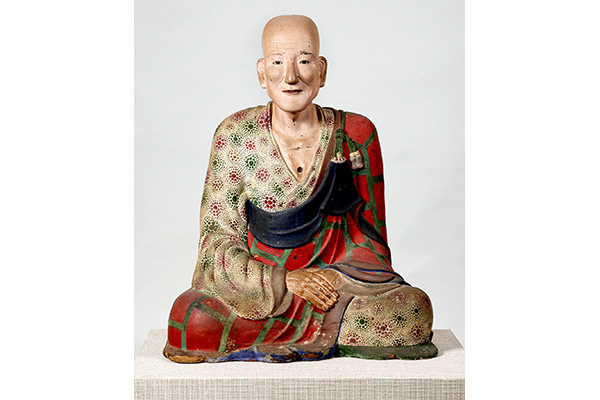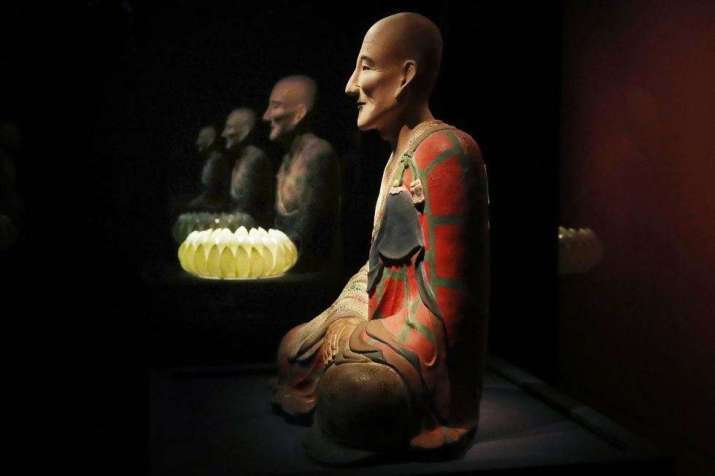
South Korea’s oldest statue of a Buddhist monk, depicting Master Huirang Daesa (889–966), will be designated a national treasure by the country’s Cultural Heritage Administration (CHA). The advance notice came on Wednesday from the CHA, with final designation expected after 30 days.
The 82-centimeter statue of Huirang is made of dry-lacquered wood and has been dated to the early 10th century. It is of particular importance because it is the oldest known sculpture of a Buddhist monk from the country.
Master Huirang Daesa was the patriarch of Haein-sa, a temple first built in 802 and located in the mountainous central heart of the peninsula in Hapcheon, South Gyeongsang Province. Today Haeinsa is a head temple for the Jogye Order of Korean Buddhism, the country’s largest Buddhist order. The Jogye school traces its origins to the Unified Silla kingdom (668–935), but only emerged as a distinct entity in the 11th century when the monk Bojo Jinul successfully taught a syncretic Buddhism drawing together Seon (Zen) practices and the doctrinal study, chanting, and lectures of the other schools.
Huirang was a renowned Buddhist monk who taught and mentored King Taejo Wang Geon (877–943), the founder of the Goryeo dynasty, which unified the Korean peninsula for the first time and lasted from 918–1392. The Goryeo was succeeded by the Joseon kingdom (1392–1897).
“People might remember Goryeo as a short-lived country, but in fact the 474-year history of Goryeo is on par with the Joseon Kingdom, which lasted for 518 years. We are more familiar with cultural heritage from Joseon, but much of Joseon’s culture is based on the legacy of Goryeo,” said Yoo Su-ran, curator of the 2018 “Goryeo: Glory of Korea” exhibition, which featured the sculpture alongside some 450 other pieces, including paintings, sculptures, celadon, and craftworks drawn together from countries as far away as the US and Italy. (The Korea Times)

The Goryeo period was also a high point for the history of Buddhism in Korea. Particularly in the first half of the dynasty, Buddhism flourished and new temples were built across the country. “During Goryeo dynasty in general, Buddhism became a unifying factor and the grounds for further national and cultural flourishing. For instance, the Tripitaka Koreana (簙缧繗蟿篏, a World Cultural Heritage) was carved into more than 80,000 woodblocks as an offering for national protection from outside forces and invasion,” noted Ven. Jinwol Lee, former dean of religious affairs at Dongguk University in Seoul. In the second half of the Goryeo, however, various factors led to a decline in Buddhism, and anti-Buddhist philosophies became predominant. By the time of the Joseon, Neo-Confusion ideals were in favor and became official aspects of the country’s administration and society.
After collecting opinions from various fields for the next 30 days, a review committee within the CHA will officially designate the statue as a National Treasure. As of May 2020, there were 327 distinct entities on Korea’s list of National Treasures, all of which have been deemed to have exceptional artistic, cultural, and historical value to the country.
References
Lee, Venerable Jinwol. 2012. “Ganhwaseon (笂贬茈) in Korea: From a Seon Practitioner’s Perspective.” In Buddhist Philosophy and Meditation Practice. pp.28–33. http://www.undv.org/vesak2012/en/book.php
See more
‘Glory of Korea’ originates from Goryeo (The Korea Times)
S. Korea’s Oldest Statue of Buddhist Monk to be Designated a National Treasure (KBS World Radio)














